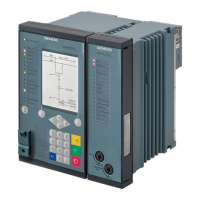Operate Curve
If the function picks up, the logarithmic inverse-time characteristic curve is processed. A time value T
op
is
calculated for every input value exceeding 95 % of the threshold value. An integrator accumulates the value
1/T
op
. If the accumulated integral reaches the fixed value 1, the stage operates.
The curve used to calculate the time value T
op
is shown in the following graphic. The curve is composed of 2
sections with different slops. 7 parameters are used to define the logarithmic inverse time with knee-point
characteristic curve. The parameter Max. time of the curve determines the initial time value of the
characteristic curve, and relates to the 3I0 Threshold value. The transition point is defined by parameter
Knee-point current and parameter Knee-point time. The parameter Min. time of the curve
indicates the lower time limit, and parameter Current at Min. time determines the current value at
Min. time of the curve. The parameter Time dial servers as a time factor to the operate time.
[dwloinkn-300913, 3, en_US]
Figure 7-118
Operate Curve of the Logarithmic Inverse Time with Knee-Point Characteristic (In the Example
of Threshold = 0.004 A)
Application and Setting Notes
Apart from the operate curve, this type of stage is almost identical to the Inverse-time overcurrent protec-
tion – advanced stage (see chapter 7.7.6.1 Description). The only difference is that the dynamic settings
change functionality is not available.
This section only discusses the nature of the operate curve. For further functionality, refer to chapter
7.7.6.2 Application and Setting Notes.
Parameter: Threshold
•
Default setting (_:3) Threshold = 1.20 A
You can use the Threshold parameter to define the pickup value of the stage corresponding to the specific
application.
7.7.8.2
Protection and Automation Functions
7.7 Directional Overcurrent Protection, Ground
SIPROTEC 5, High-Voltage Bay Controller, Manual 737
C53000-G5040-C015-9, Edition 11.2017

